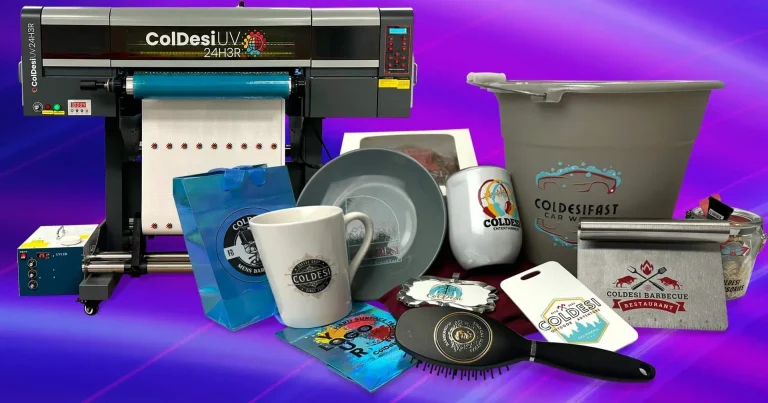In the realm of modern printing technologies, UV DTF printing has emerged as a game-changing solution that combines the precision of UV printing technology with the efficiency of direct-to-film (DTF) methods. This innovative approach allows for stunning print quality on a variety of surfaces, making it ideal for custom UV printing applications across multiple industries. With the ability to produce vibrant, durable prints at a rapid pace, UV DTF printers are redefining the standard for promotional products, personalized apparel, and intricate designs. Moreover, the environmental benefits associated with low VOC emissions in the inks used further elevate its appeal. As businesses increasingly seek adaptability and high-quality production, understanding the nuances of UV DTF printing becomes essential for staying competitive in today’s market.
Exploring the world of UV DTF technology reveals a fascinating interplay between direct-to-film printing and the capabilities of ultraviolet curing processes. Often referred to as UV direct-to-film printing, this cutting-edge method offers a heightened level of detail and durability, perfect for various printing applications. Whether you’re involved in the fashion sector or the creation of bespoke signage, the impact of utilizing a UV DTF printer cannot be overstated. This printing technique is designed to meet the growing demand for personalized products while maintaining exceptional quality. Hence, mastering this technology not only enhances product offerings but also positions businesses strategically within the competitive landscape of custom printing.
The Fundamentals of UV Printing Technology
UV printing technology revolutionizes the printing industry by utilizing ultraviolet light to cure or dry the ink as it is printed. Unlike conventional methods that often use solvent inks, UV inks are cured instantly, allowing for vibrant colors and sharp details. This technique provides the ability to print on a variety of substrates, broadening the scope for creative applications. For anyone looking to delve into printing, understanding the mechanics of UV printing is crucial as it forms the basis for more advanced technologies like UV DTF printing.
Moreover, the benefits of UV printing are not just technical; they also extend to eco-friendliness. The inks often emit low levels of volatile organic compounds (VOCs), making them a more sustainable option without compromising quality. As the demand for swift delivery and customization in the printing sector increases, UV printing technology emerges as a clear frontrunner, paving the way for innovations such as UV DTF, which takes full advantage of its capabilities.
Frequently Asked Questions
What is UV DTF printing and how does it work?
UV DTF printing, or Direct to Film printing, utilizes ultraviolet light to cure inks on a specially coated film, which can then be transferred onto various surfaces. This method combines features of UV printing technology with direct-to-film applications, producing vibrant and durable prints.
What are the benefits of using a UV DTF printer over traditional printing methods?
The main benefits of using a UV DTF printer include high-quality prints with exceptional color accuracy, durability against wear and fading, faster production times, and environmentally friendly inks with low VOC emissions, making it a superior choice for diverse printing applications.
What materials can be printed on using UV DTF printing technology?
UV DTF printing can be applied to a wide range of materials including plastics, wood, metal, and textiles, making it highly versatile for various projects such as custom apparel, promotional items, and signage.
How does UV DTF printing compare to traditional DTF printing?
Unlike traditional DTF printing which relies on heat transfer, UV DTF printing employs UV light to instantly cure inks, resulting in quicker turnaround times, higher detail resolution, and improved durability of the prints.
What industries benefit the most from UV DTF printing applications?
Industries such as fashion, signage, and promotional products greatly benefit from UV DTF printing applications, as it provides them with the ability to produce unique, high-quality items quickly and efficiently.
How can beginners get started with UV DTF printing technology?
Beginners can start with UV DTF printing by selecting the right printer, investing in quality materials like films and inks, and utilizing online resources such as tutorials and workshops to learn effective printing techniques.
| Key Points | |
|---|---|
| Definition and Process | UV DTF printing is a technology that uses UV light to cure ink on a coated film and transfer designs onto various materials. |
| Benefits | 1. Exceptional quality and detail for intricate designs. 2. Durable prints resistant to wear and fading. 3. Quick turnaround times for efficient business operations. 4. Environmentally friendly due to low VOC emissions. |
| Applications | Used in fashion (apparel, accessories), signage (vibrant displays), and promotional products (gifts, merchandise). |
| Getting Started | Select a suitable printer, invest in quality materials, and utilize educational resources for learning. |
| Market Trends | Growth driven by demand for customized products; innovations leading to faster production and broader color ranges. |
Summary
UV DTF printing is revolutionizing the printing industry by combining innovation, quality, and efficiency. This advanced technology allows for high-quality graphics to be applied to a diverse range of materials, making it ideal for various applications from fashion to signage. As market demand for personalized and customizable products continues to grow, UV DTF printing positions itself as a reliable and effective solution for businesses looking to enhance their offerings. For those looking to enter this field, understanding the fundamental processes and benefits of UV DTF printing can pave the way for successful endeavors and greater market competitiveness.


